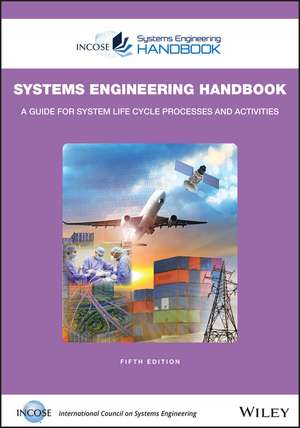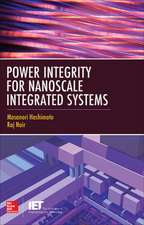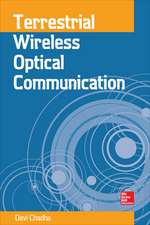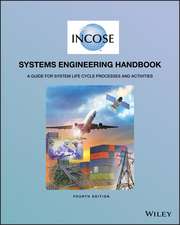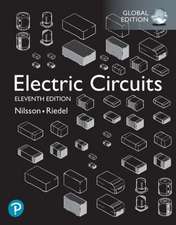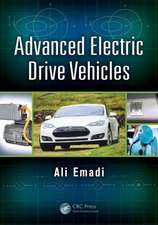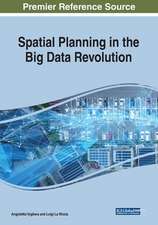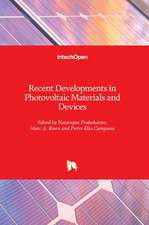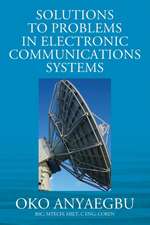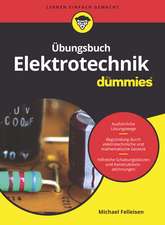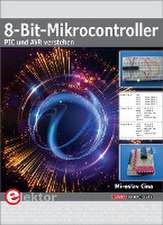INCOSE Systems Engineering Handbook, Fifth Edition
Autor INCOSEen Limba Engleză Paperback – 3 sep 2023
A comprehensive reference on the discipline and practice of systems engineering Systems engineering practitioners provide a wide range of vital functions, conceiving, developing, and supporting complex engineered systems with many interacting elements. The International Council on Systems Engineering (INCOSE) Systems Engineering Handbook describes the state-of-the-good-practice of systems engineering. The result is a comprehensive guide to systems engineering activities across any number of possible projects. From automotive to defense to healthcare to infrastructure, systems engineering practitioners are at the heart of any project built on complex systems. INCOSE Systems Engineering Handbook readers will find: * Elaboration on the key systems life cycle process described in ISO/IEC/IEEE 15288; * Chapters covering key systems engineering concepts, system life cycle processes and methods, tailoring and application considerations, systems engineering in practice, and more; and * Appendices, including an N² diagram of the systems engineering processes and a detailed topical index. The INCOSE Systems Engineering Handbook is a vital reference for systems engineering practitioners and engineers in other disciplines looking to perform or understand the discipline of systems engineering.
Preț: 466.18 lei
Preț vechi: 582.73 lei
-20% Nou
89.21€ • 95.39$ • 74.38£
Carte disponibilă
Livrare economică 27 martie-10 aprilie
Livrare express 13-19 martie pentru 42.18 lei
Specificații
ISBN-10: 1119814294
Pagini: 368
Dimensiuni: 203 x 254 x 20 mm
Greutate: 0.8 kg
Ediția:5th Edition
Editura: Wiley
Locul publicării:Hoboken, United States
Notă biografică
David D. Walden, ESEP, is Co-Owner and Principal Consultant for Sysnovation, which provides Systems Engineering training and consulting throughout the world. He is an INCOSE ESEP, a Senior Member of the IEEE, member of Tau Beta Pi, and the recipient of the INCOSE Founders Award. He resides in the USA. Dr. Thomas M. Shortell, CSEP, is a Project Specialist Senior Staff at Lockheed Martin and an adjunct professor at Drexel University. He is an INCOSE CSEP and is co-lead of the INCOSE Future of Systems Engineering (FuSE) Initiative. He resides in the USA. Garry J. Roedler, ESEP, is a retired Senior Fellow and Engineering Outreach Program Manager for Lockheed Martin Corporation. Garry is a Past President of INCOSE. He is an INCOSE ESEP and Fellow, the recipient of the INCOSE Founders Award, the IEEE-SA Lifetime Achievement Award, the IEEE-CS Golden Core, the USC CSSE Lifetime Achievement Award, the Lockheed Martin Technical Leadership Award, and the Lockheed Martin NOVA Award, among others. He resides in the USA. Dr. Bernardo A. Delicado, ESEP, is a senior Systems Engineer with significant experience in collaborative Aerospace and Defense projects at European level. He was founding member of AEIS (The INCOSE Spain Chapter) and its President, the first Spaniard to earn an INCOSE ESEP certification, a member of INCOSE Advisory Certification Group (CAG), and a Systems Engineering Body of Knowledge (SEBoK) Editor. He resides in Spain. Odile Mornas, ESEP, is a graduate of the Ecole Nationale Supérieure de Mécanique et des Microtechniques (ENSMM). She holds a post-graduate degree and has worked for 40 years at Thales, including 15 years as a senior Systems Engineering expert and internal trainer. She is an INCOSE ESEP. She resides in France. Yip Yew-Seng, CSEP, is a founding management committee member of the INCOSE Singapore Chapter and was its President. His work experience includes Singapore Technologies Engineering, Agilent, A*STAR, Motorola, Singapore Institute of Technology (SIT) and telecommunications companies in Singapore, USA, UK, Israel, China, and Cambodia. He resides in Singapore and is its first INCOSE CSEP. Dr. David Endler, ESEP, is a Systems Engineering Consultant, Trainer, and Coach. He is the Project Editor of ISO/IEC/IEEE 15288 and was INCOSE's Technical Director. He is an INCOSE ESEP and GfSE SE-ZERT(r) Level A. He resides in Germany.
Descriere
A comprehensive reference on the discipline and practice of systems engineering Systems engineering practitioners provide a wide range of vital functions, conceiving, developing, and supporting complex engineered systems with many interacting elements. The International Council on Systems Engineering (INCOSE) Systems Engineering Handbook describes the state-of-the-good-practice of systems engineering. The result is a comprehensive guide to systems engineering activities across any number of possible projects. From automotive to defense to healthcare to infrastructure, systems engineering practitioners are at the heart of any project built on complex systems. INCOSE Systems Engineering Handbook readers will find: * Elaboration on the key systems life cycle process described in ISO/IEC/IEEE 15288; * Chapters covering key systems engineering concepts, system life cycle processes and methods, tailoring and application considerations, systems engineering in practice, and more; and * Appendices, including an N² diagram of the systems engineering processes and a detailed topical index. The INCOSE Systems Engineering Handbook is a vital reference for systems engineering practitioners and engineers in other disciplines looking to perform or understand the discipline of systems engineering.
Cuprins
Contents INCOSE Notices ix History of Changes xi List of Figures xiii List of Tables xvii Preface xix How to Use This Handbook xxi 1 Systems Engineering Introduction 1 1.1 What Is Systems Engineering? 1 1.2 Why Is Systems Engineering Important? 4 1.3 Systems Concepts 8 1.3.1 System Boundary and the System of Interest (SoI) 8 1.3.2 Emergence 9 1.3.3 Interfacing Systems, Interoperating Systems, and Enabling Systems 10 1.3.4 System Innovation Ecosystem 11 1.3.5 The Hierarchy within a System 12 1.3.6 Systems States and Modes 14 1.3.7 Complexity 15 1.4 Systems Engineering Foundations 15 1.4.1 Uncertainty 15 1.4.2 Cognitive Bias 17 1.4.3 Systems Engineering Principles 17 1.4.4 Systems Engineering Heuristics 20 1.5 System Science and Systems Thinking 21 2 System Life Cycle Concepts, Models, and Processes 25 2.1 Life Cycle Terms and Concepts 25 2.1.1 Life Cycle Characteristics 25 2.1.2 Typical Life Cycle Stages 26 2.1.3 Decision Gates 29 2.1.4 Technical Reviews and Audits 31 2.2 Life Cycle Model Approaches 33 2.2.1 Sequential Methods 35 2.2.2 Incremental Methods 36 2.2.3 Evolutionary Methods 38 2.3 System Life Cycle Processes 39 2.3.1 Introduction to the System Life Cycle Processes 39 2.3.1.1 Format and Conventions 40 2.3.1.2 Concurrency, Iteration, and Recursion 42 2.3.2 Agreement Processes 44 2.3.2.1 Acquisition Process 45 2.3.2.2 Supply Process 48 2.3.3 Organizational Project-Enabling Processes 50 2.3.3.1 Life Cycle Model Management Process 51 2.3.3.2 Infrastructure Management Process 54 2.3.3.3 Portfolio Management Process 57 2.3.3.4 Human Resource Management Process 60 2.3.3.5 Quality Management Process 63 2.3.3.6 Knowledge Management Process 67 2.3.4 Technical Management Processes 70 2.3.4.1 Project Planning Process 70 2.3.4.2 Project Assessment and Control Process 75 2.3.4.3 Decision Management Process 78 2.3.4.4 Risk Management Process 81 2.3.4.5 Configuration Management Process 87 2.3.4.6 Information Management Process 91 2.3.4.7 Measurement Process 93 2.3.4.8 Quality Assurance Process 98 2.3.5 Technical Processes 101 2.3.5.1 Business or Mission Analysis Process 103 2.3.5.2 Stakeholder Needs and Requirements Definition Process 107 2.3.5.3 System Requirements Definition Process 112 2.3.5.4 System Architecture Definition Process 118 2.3.5.5 Design Definition Process 124 2.3.5.6 System Analysis Process 129 2.3.5.7 Implementation Process 132 2.3.5.8 Integration Process 134 2.3.5.9 Verification Process 138 2.3.5.10 Transition Process 143 2.3.5.11 Validation Process 146 2.3.5.12 Operation Process 152 2.3.5.13 Maintenance Process 154 2.3.5.14 Disposal Process 156 3 Life Cycle Analyses and Methods 159 3.1 Quality Characteristics and Approaches 159 3.1.1 Introduction to Quality Characteristics 159 3.1.2 Affordability Analysis 160 3.1.3 Agility Engineering 165 3.1.4 Human Systems Integration 168 3.1.5 Interoperability Analysis 171 3.1.6 Logistics Engineering 172 3.1.7 Manufacturability/Producibility Analysis 175 3.1.8 Reliability, Availability, Maintainability Engineering 176 3.1.9 Resilience Engineering 180 3.1.10 Sustainability Engineering 184 3.1.11 System Safety Engineering 185 3.1.12 System Security Engineering 190 3.1.13 Loss-Driven Systems Engineering 191 3.2 Systems Engineering Analyses and Methods 192 3.2.1 Modeling, Analysis, and Simulation 192 3.2.2 Prototyping 200 3.2.3 Traceability 201 3.2.4 Interface Management 202 3.2.5 Architecture Frameworks 206 3.2.6 Patterns 208 3.2.7 Design Thinking 212 3.2.8 Biomimicry 213 4 Tailoring and Application Considerations 215 4.1 Tailoring Considerations 215 4.2 SE Methodology/Approach Considerations 219 4.2.1 Model-Based SE 219 4.2.2 Agile Systems Engineering 221 4.2.3 Lean Systems Engineering 224 4.2.4 Product Line Engineering (PLE) 226 4.3 System Types Considerations 229 4.3.1 Greenfield/Clean Sheet Systems 229 4.3.2 Brownfield/Legacy Systems 230 4.3.3 Commercial-off-the-Shelf (COTS)-Based Systems 231 4.3.4 Software-Intensive Systems 232 4.3.5 Cyber-Physical Systems (CPS) 233 4.3.6 Systems of Systems (SoS) 235 4.3.7 Internet of Things (IoT)/Big Data-Driven Systems 238 4.3.8 Service Systems 239 4.3.9 Enterprise Systems 241 4.4 Application of Systems Engineering for Specific Product Sector or Domain Application 244 4.4.1 Automotive Systems 245 4.4.2 Biomedical and Healthcare Systems 248 4.4.3 Commercial Aerospace Systems 249 4.4.4 Defense Systems 250 4.4.5 Infrastructure Systems 251 4.4.6 Oil and Gas Systems 253 4.4.7 Power & Energy Systems 254 4.4.8 Space Systems 255 4.4.9 Telecommunication Systems 257 4.4.10 Transportation Systems 258 5 Systems Engineering in Practice 261 5.1 Systems Engineering Competencies 261 5.1.1 Difference between Hard and Soft Skills 262 5.1.2 System Engineering Professional Competencies 263 5.1.3 Technical Leadership 263 5.1.4 Ethics 264 5.2 Diversity, Equity, and Inclusion 265 5.3 Systems Engineering Relationships to Other Disciplines 266 5.3.1 SE and Software Engineering (SWE) 266 5.3.2 SE and Hardware Engineering (HWE) 267 5.3.3 SE and Project Management (PM) 268 5.3.4 SE and Industrial Engineering (IE) 270 5.3.5 SE and Operations Research (OR) 271 5.4 Digital Engineering 273 5.5 Systems Engineering Transformation 274 5.6 Future of SE 275 6 Case Studies 277 6.1 Case 1: Radiation Therapy--the Therac-25 277 6.2 Case 2: Joining Two Countries--the Øresund Bridge 278 6.3 Case 3: Cybersecurity Considerations in Systems Engineering--the Stuxnet Attack on a Cyber-Physical System 280 6.4 Case 4: Design for Maintainability--Incubators 282 6.5 Case 5: Artificial Intelligence in Systems Engineering--Autonomous Vehicles 283 6.6 Other Case Studies 285 Appendix A: References 287 Appendix B: Acronyms 305 Appendix C: Terms and Definitions 311 Appendix D: N2 Diagram of Systems Engineering Processes 317 Appendix E: Input/Output Descriptions 321 Appendix F: Acknowledgments 335 Appendix G: Comment Form 337 Index 339
